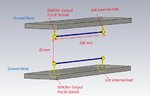zionico90
Member level 2
Hi guys,
i would try to simulate (in easy way in order to have only an approximate value) the coupling between two wire. The distance is set to 30mm, the diameter is 35um and the length 130mm. I have calculate an inductance equal to 230nH and a capacitance equal to 0.1 pF.
These two wires are grounded on a different reference plane with capacitance 0.5pF. In order to taking into account the isolating between the reference plane i have introduce a higher resistance.
R=500ohm is the source output and R=10Kohm is the external load.
The equivalent model is shown in attachment; is the correct way to simulate this system?
Thank you
p.s: is my first equivalent model circuit
View attachment eq.bmp
i would try to simulate (in easy way in order to have only an approximate value) the coupling between two wire. The distance is set to 30mm, the diameter is 35um and the length 130mm. I have calculate an inductance equal to 230nH and a capacitance equal to 0.1 pF.
These two wires are grounded on a different reference plane with capacitance 0.5pF. In order to taking into account the isolating between the reference plane i have introduce a higher resistance.
R=500ohm is the source output and R=10Kohm is the external load.
The equivalent model is shown in attachment; is the correct way to simulate this system?
Thank you
p.s: is my first equivalent model circuit
View attachment eq.bmp
